We’ll be undertaking a field project off the island of Hawaiʻi from October 28 through November 10, 2019, our second project off the island this year. This project is funded by a contract from the Northwest Fisheries Science Center and by a grant from the Pacific Islands Fisheries Science Center.
We have two main goals for this effort: 1) breath sampling (using a drone) from short-finned pilot whales to examine their respiratory microbiome (in collaboration with Linda Rhodes at the Northwest Fisheries Science Center); and 2) to learn more about the endangered main Hawaiian Islands population of false killer whales. This second goal has a lot of different components: photo-identification to help estimate abundance and examine life history; biopsy sampling for sex and age (using epigenetic aging) determination as well as for studies of hormone chemistry; use of a drone to examine body condition and collect breath samples; and, if we are lucky, deploy one or more satellite tags to examine movements.
As we do during all of our field projects, we will also be obtaining photos from most species of odontocetes we encounter (we have photo-ID catalogs of 11 different species) to contribute to ongoing studies of residency patterns and social organization and to estimate population sizes, and collecting biopsy samples for hormone chemistry, toxicology, and genetic studies. We’ll also be obtaining photos of any rare seabirds we see and collecting any squid we find to better understand what prey species are available for odontocetes in Hawaiʻi. Like our November 2018 project, we will also have a land-based team, using a high-power spotting scope and high-power binoculars to simultaneously monitor species from a shore-based vantage, helping increase the encounter rate for the boat-based team and learning more about how different species are using the area.
The boat-based team includes Colin Cornforth, Jordan Lerma, Brittany Guenther, Annie Douglas, Michaela Kratofil, and Robin Baird, and the land-based team is led by Michelle Nason and Preston-Eric Hamren, with a number of volunteers helping out both teams.
End of project update

Another very successful project! The land-based crew (including 14 different volunteers for a total of 32 volunteer days!) had sightings of 52 different groups of dolphins and whales, including pilot whales, false killer whales, and spinner, bottlenose and spotted dolphins! The land-based crew were able to direct the boat to a number of different groups and sub-groups, and covered a broad area off of Kailua-Kona, so that even when there were no sightings that allowed the boat to search elsewhere!
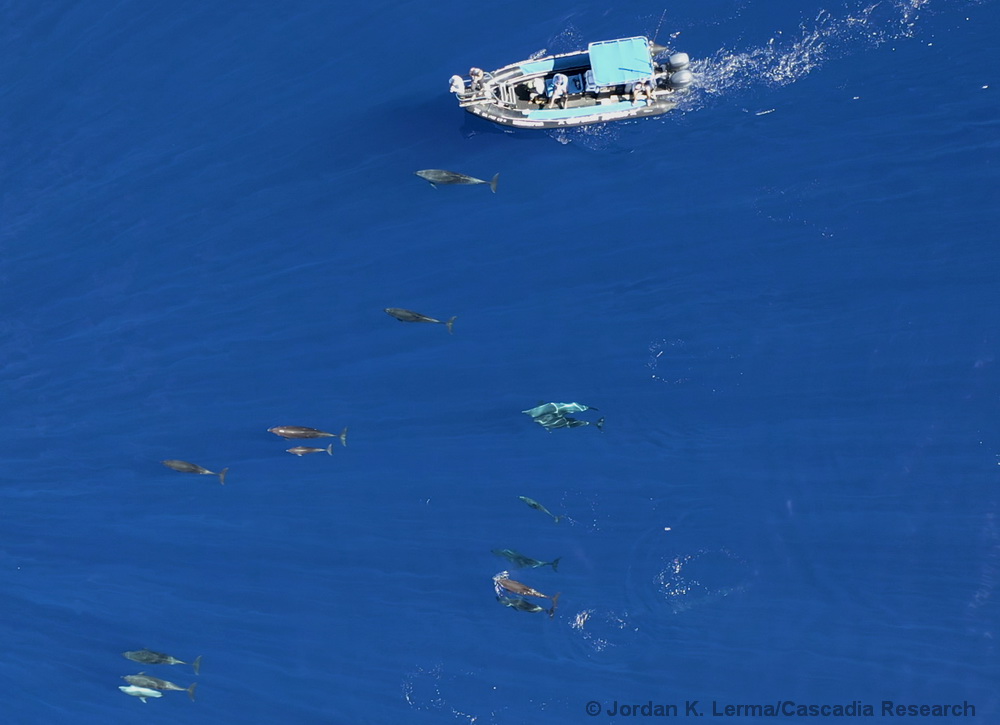
The boat-based crew was equally successful, with 56 encounters with 10 different species, including 23 groups of short-finned pilot whales, seven groups each of bottlenose (including the group above) and pantropical spotted dolphins, four groups each of melon-headed whales and Cuvier’s beaked whales, three groups of rough-toothed dolphins, and two groups each of false killer whales, Blainville’s beaked whales, dwarf sperm whales, and spinner dolphins! We took over 38,000 photos of odontocetes and 4,098 photos of seabirds, collected 10 breath samples, 1 fecal sample, 1 mucous sample, 5 squid, and 24 biopsy samples, and deployed two satellite tags.

A pantropical spotted leaping next to the boat, November 8, 2019. This individual has a recent wound from a cookie-cutter shark bite below the dorsal fin.

Our sightings of bottlenose dolphins this trip have been a bit unusual, in that the groups have been found in much deeper water than we typically see them off the islands. Bottlenose dolphins around the main Hawaiian Islands are typically found in fairly shallow water, less than 500 m deep and most often in depths less than 200 m deep. This trip we’ve had seven sightings, in depths ranging from 600 to almost 1,800 m depth, including a large group (18 individuals) seen on our last day on the water. Several of the individuals had unusual wounds, including the individual above (which also has a small remora just below the eye), and the individuals below.

This individual has a linear cut on the leading edge of the dorsal fin, almost severing the fin, likely the result of an interaction with fishing gear.

Our bottlenose dolphin catalog includes over 200 distinctive individuals from this island, and we’ll be comparing photos from these groups to determine whether they are part of the resident insular population, are part of an offshore population, or represent a group moving from one of the other insular populations.
November 7th update

Today we had only two encounters, the first with a group of seven Blainville’s beaked whales where we were able to get identification photos of all individuals and collect three biopsy samples, and the second with members of the endangered main Hawaiian Islands population of false killer whales, our highest priority species! We were able to get identification photos of perhaps 20 individuals and collected four biopsy samples that will be used for studies of genetics, stable isotopes, toxicology and hormone chemistry.

The group was moving rapidly north along the Kona coast for most of the day, and as is typical for this species was spread out over a wide area, ranging from nearshore to at least five kilometers offshore. As well as the ID photos and biopsies were were also able to get drone images (for photogrammetry) of three different individuals.

Although these individuals regularly pass by the Kona coast, this is the first time we’ve been able to get photos of them passing by the kampachi (aka kahala) fish farm.
November 6th update

We had our second encounter with dwarf sperm whales today, a group of three individuals that we were able to get good identification photos of. Like our first encounter with this species, we used the drone to keep track of the group and get footage of behavior not visible from the surface. This photo shows the unusual head shape of this species, the blowhole shifted to the left side of the body, as is the case with its larger cousin the sperm whale.

Most of the photos on this web page are cropped at least a bit, and certainly most of our photos of dwarf sperm whales are usually cropped to show the subject better, given they are typically taken at quite a distance. The photo above (and the one below) are both shown uncropped, to give you an idea of how close we were able to get to these individuals (photos taken with a 400 mm lens and a Canon 7DII which has a 1.6x focal length crop). Getting close to this species requires a lot of patience – approaching too quickly will easily disturb them – our secret it to take it slow to minimize the chances of disturbing them, which sometimes pays off.

A dwarf sperm whale off the south Kona coast.
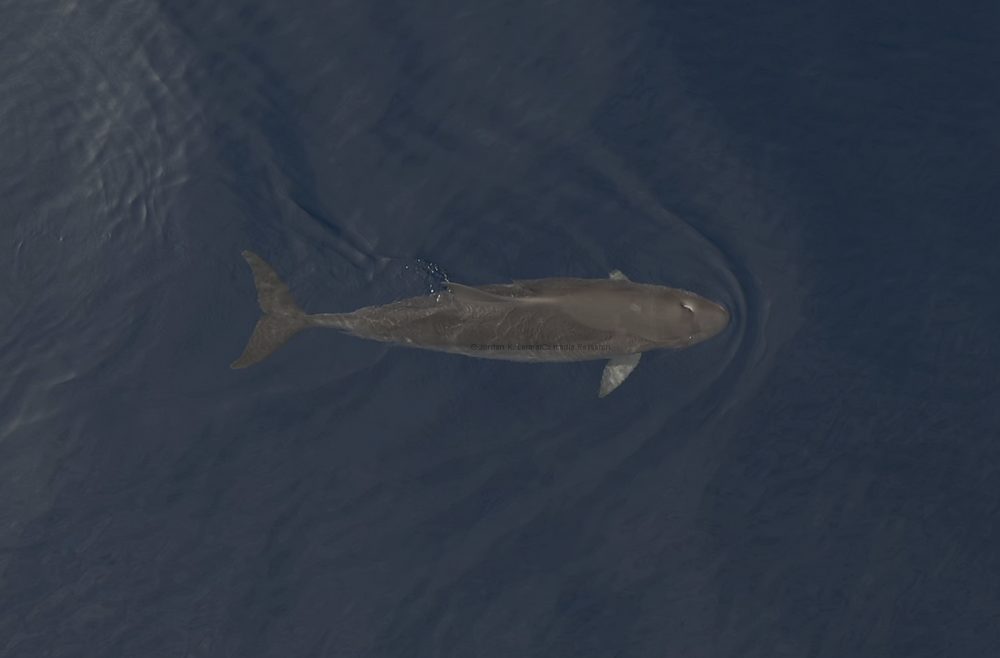
An aerial image of one of the dwarf sperm whales from today.
November 5th update
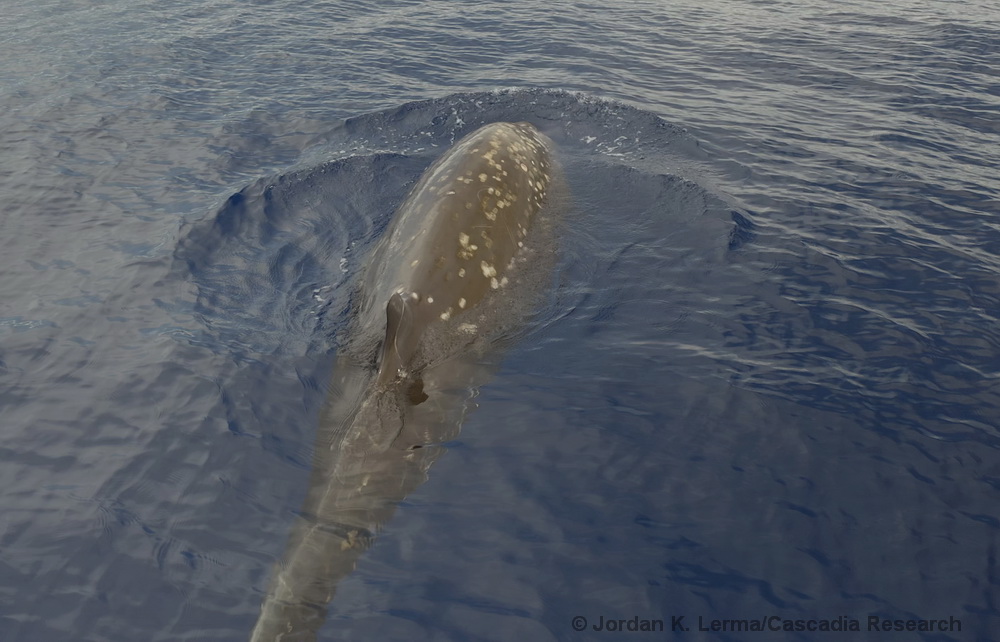
Another day, another Cuvier’s beaked whale encounter. Today’s was definitely a milestone – not only did we get the drone up in order to get better images to confirm sex (an adult female) and identify the individual, we managed to collect a breath sample from this individual! We think this may be the first breath sample collected from a beaked whale by drone?

This photo shows the drone flying through the exhalation plume of the adult female Cuvier’s beaked whale today. Today we also collected several breath samples from short-finned pilot whales, and had yet another encounter with melon-headed whales!
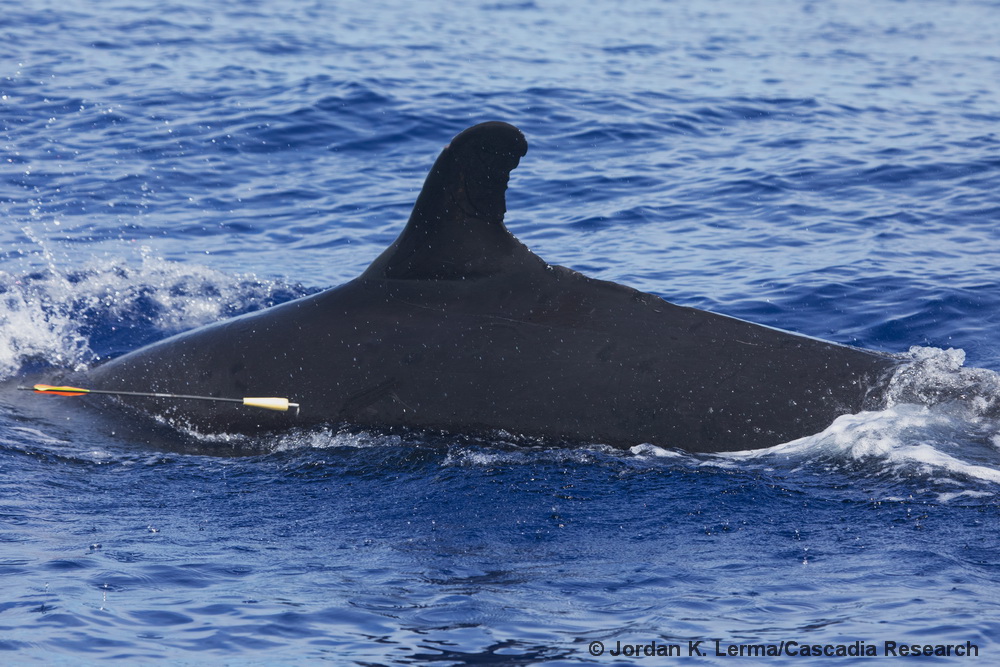
The photo above shows a biopsy sample being collected from a false killer whale earlier this trip – the biopsy dart is shown just after it bounces back from the individual, and a small bit of blubber is visible in the biopsy tip (which is 8 mm in diameter and penetrates ~15 mm). You can also see the yellow float on the biopsy dart, allowing us to recover the arrow and keeping the tip from penetrating. While we collect biopsy samples on every project, this trip we’ve been subsampling the skin from biopsies for a study by Ph.D. student Matthew Schmitz of the Pollen Lab of the University of California San Francisco. A short description from Matthew of what they are using the samples for: “We study the evolution of intelligence by reprogramming skin fibroblasts to induced pluripotent stem cells, then using these to generate brain cells. These stem cells are a renewable resource that can be grown indefinitely and used to study any tissue in the body, aiding conservation efforts and allowing species-specific cellular traits to be modeled in a dish without having to further sample tissue from wild animals. Because cetaceans have large brains and intelligence that is comparable to humans, but have evolved completely independently from humans, we hope to understand how the brain architectures that confer complex intelligence form during development, and to further understand similarities between cetacean and primate brains. Furthermore, reprogrammed stem cells could also enable toxicology studies in many different cell and tissue types.” We are excited to be involved with this project – check out their website www.pollenlab.org for more information on this work.
November 4th update

In our eight days on the water we’ve encountered beaked whales on four of them, an unusually high rate of beaked whale sightings for this area. We encountered Cuvier’s on both November 3rd and November 4th, a pair on November 3rd and a trio on the 4th. The photo above shows a likely adult female. As well as the large number of white oval cookie-cutter shark bite scars, areas of brown diatoms can be seen over the normal background gray coloration of this species.

An adult female Cuvier’s beaked whale photographed by our drone. We’ve matched this individual to our photo-ID catalog as HIZc062, first seen in 2009 and last seen in 2012. This individual is particularly interesting as it is missing the rostrum. The sighting history of this individual was included in a 2017 publication on “Beaked whales with rostrum deformities: implications for survival and reproduction” – we were excited to document this individual again, and, like when it was last seen in 2012, it had a calf with it, suggesting it has reproduced at least twice, even with the deformity that could potentially influence feeding.
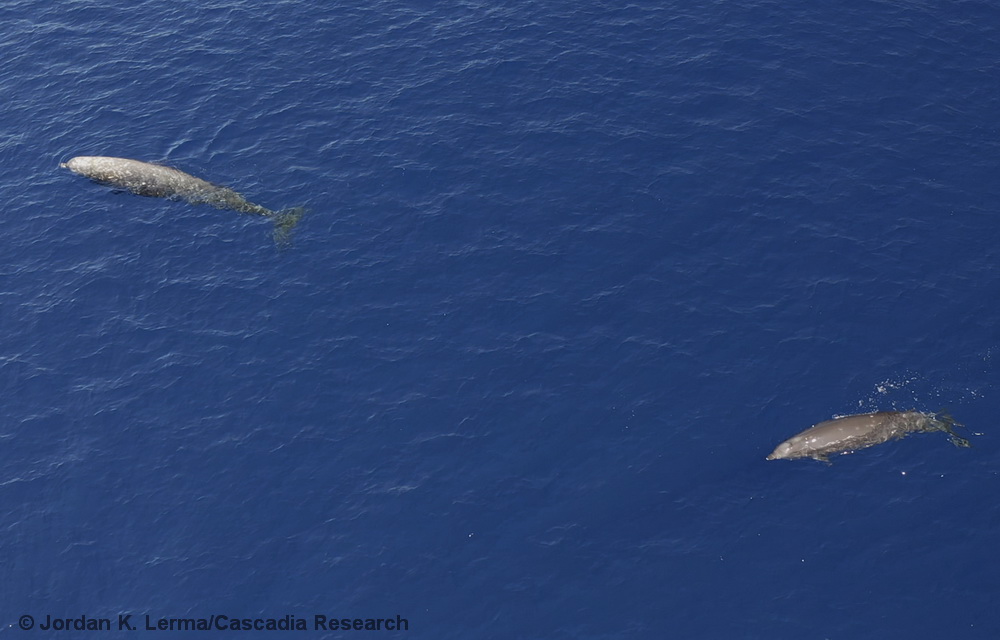
November 2nd update

A Kermadec Petrel taking off after scavenging from a large dead squid. This is the first sighting of a Kermadec Petrel we’ve had this trip, a species that is seen relatively infrequently around the islands.

A photo of the squid from November 2nd. We collect squid that we find floating at the surface, and send them to William Walker at the Marine Mammal Laboratory in Seattle for identification. Most of the squid we find were probably brought up to the surface by deep-diving cetaceans.

On November 2nd we also had a rare sighting of an Olive Ridley sea turtle offshore of Kona – this individual had a deformed carapace, but appeared to be able to dive normally.

On November 2nd we also encountered a lone juvenile pantropical spotted dolphin far offshore. This individual was behaving quite strangely, logging at the surface, occasionally sticking its head out of the water while floating motionless, alternating with leaping, in an attempt to get rid of the remora.
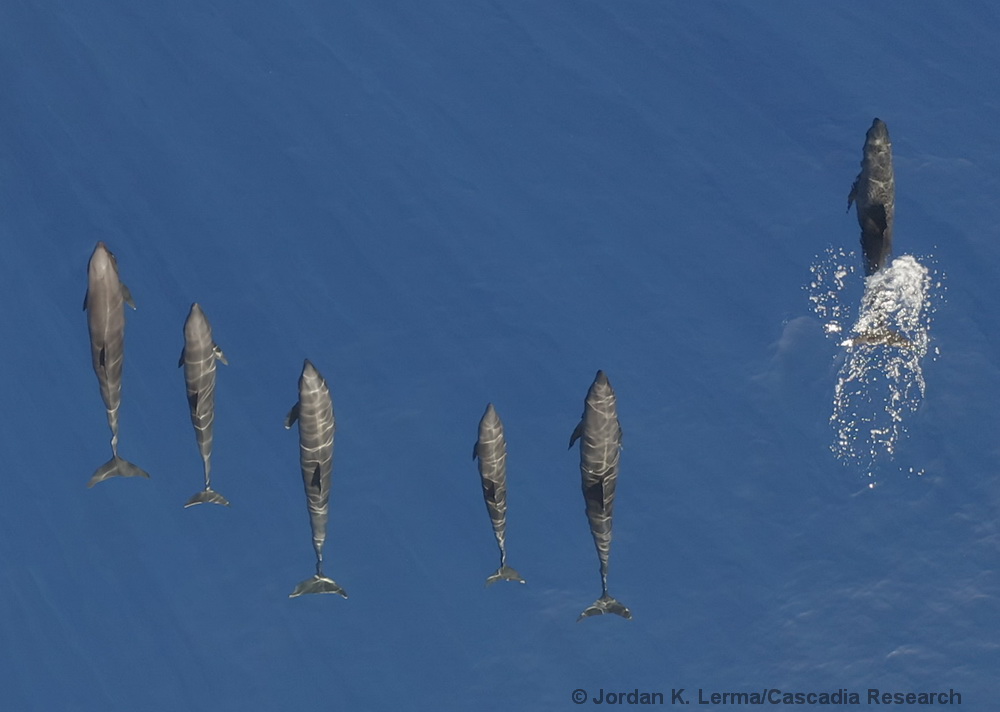
On November 1st we encountered our 10th species of odontocete for the trip, a group of about 110 melon-headed whales. This group is probably part of the Kohala resident population of melon-headed whales, a small (~450 individuals) population that is genetically differentiated from the more widely-ranging Hawaiian Islands population. Check out our melon-headed whale web page for more information on this species.
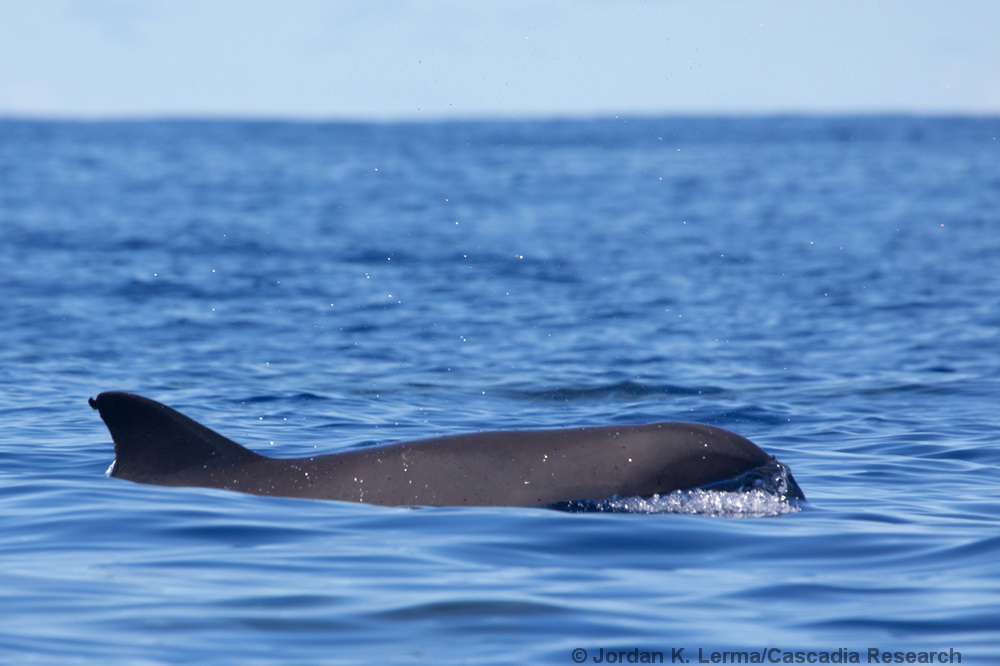
A boat-based view of one of the melon-headed whales seen November 1st, showing the gray coloration and lack of a distinct margin between the darker cape and lighter sides.
October 31st update
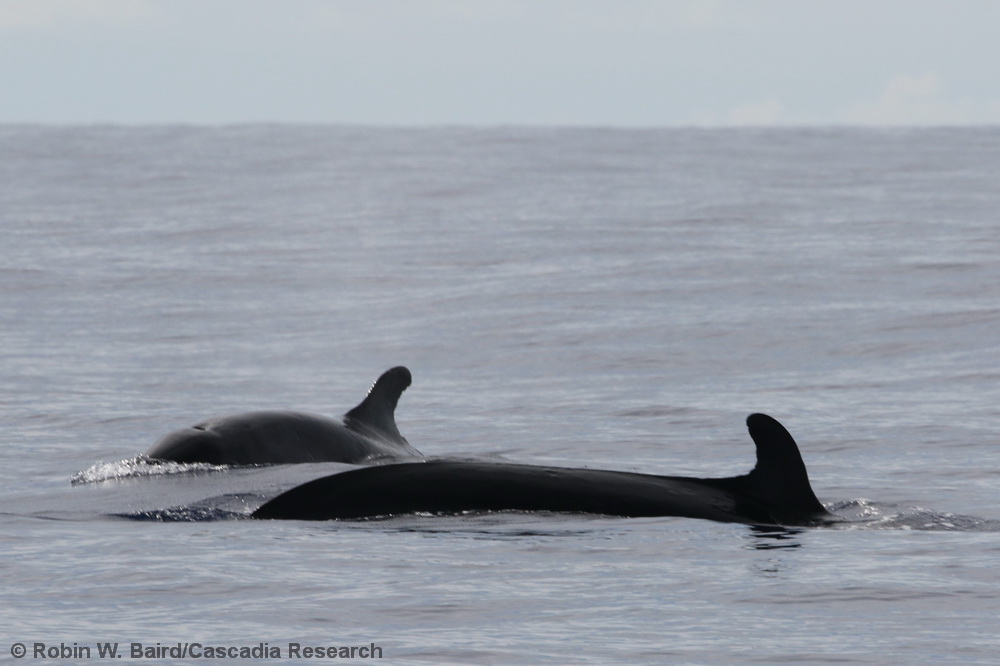
Today we encountered our highest priority species for the trip, false killer whales! We had swung far offshore of Kona, taking advantage of the calm seas, and encountered a group of ~15 individuals spread over a wide area. Although we haven’t compared the photos to our catalog yet, we suspect these individuals are from the pelagic population, rather than the endangered main Hawaiian Islands population. We’ll be able to confirm this both with photos and from genetic analyses of biopsy samples obtained, since the two populations are distinct. It was a long day so just one photo for now, but we hope to post more from this encounter in the coming days. Check out our web page on this species for more information.

We also had an amazing number of sightings of petrels offshore today (~80), and were able to get photos of perhaps 50 individual birds. This photo is of a Hawaiian Petrel, swooping down to land near the false killer whales as they were feeding on an ahi (yellowfin tuna), to scavenge bits from the fish.
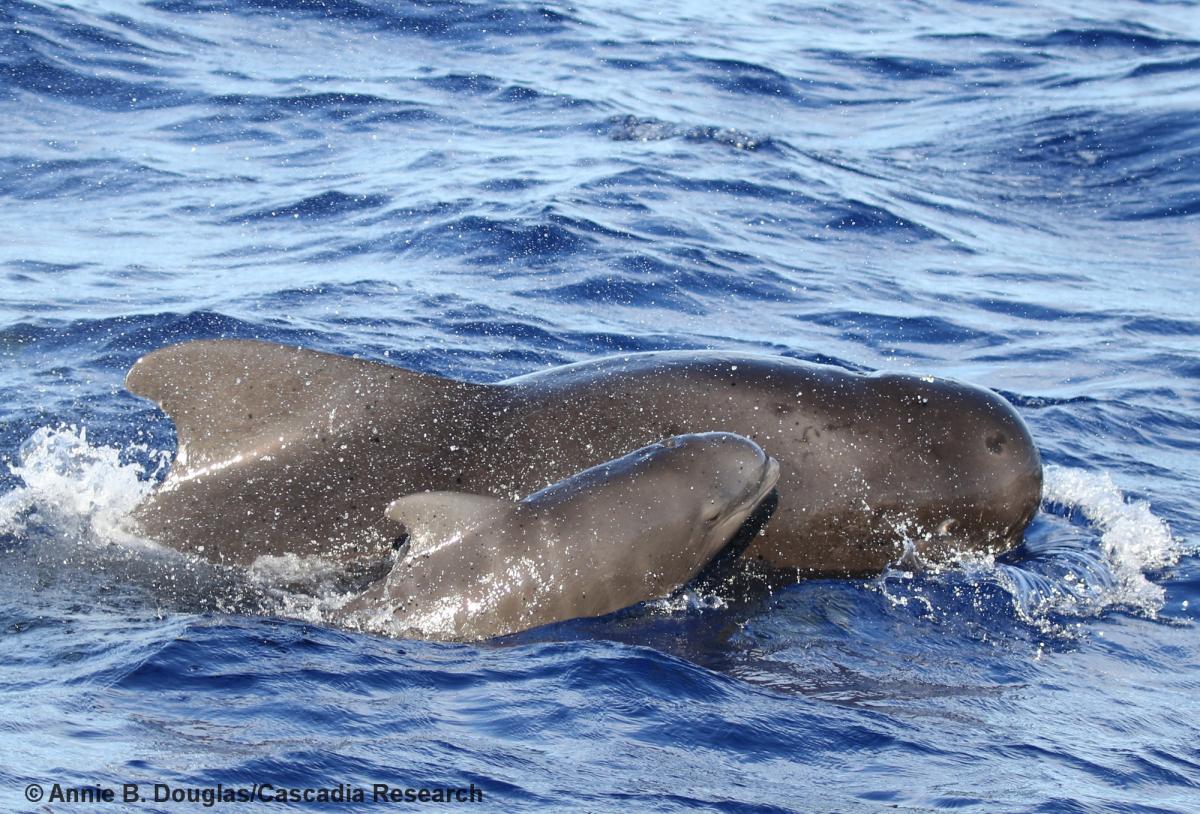
Today was the first day we didn’t see any pilot whales – this photo of a mother and newborn short-finned pilot whale was taken yesterday, October 30, 2019
October 29th update

On our second day on the water we encountered both Cuvier’s and Blainville’s beaked whales! The photo above shows a group of four Blainville’s beaked whales, taken from the drone. Our sighting of Cuvier’s was brief, but the Blainville’s beaked whales were quite cooperative.

The group included four individuals, two adult females that are well-known residents to the island, and two young calves. This calf, estimated at just over six months of age, seemed quite curious about us and regularly approached the boat. The brown coloration on this animal are diatoms.

We must have first found the Blainville’s beaked whales shortly after they came up from a long dive, as they stayed at the surface for an extended period. This adult female, HIMd007 in our photo-ID catalog, was first documented off the island in 1997, and was the first Blainville’s we saw when we started work off this island in 2002! This individual is covered in white oval scars from cookie-cutter shark bites, giving an indication of its age. For more information on beaked whales in Hawai‘i check out our beaked whale web page.

One of the two calves seemed very independent, regularly leaving its mother and joining the other calf.
October 28 update
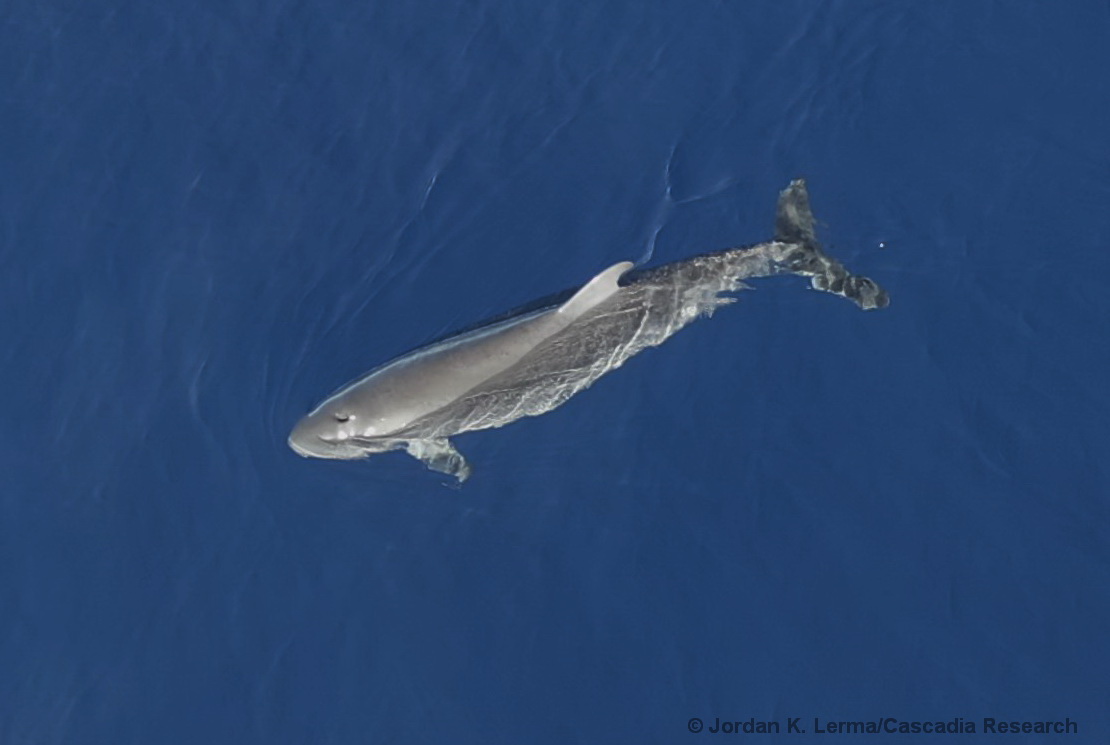
On our first day on the water we had seven encounters with four different species of odontocetes, but by far the most exciting was a sighting of four dwarf sperm whales. This species isn’t the most demonstrative (e.g., they rarely breach), and we often (or usually) only get brief glimpses of them, but they are exciting based both on their rarity and on the fact that there is a small resident population off this island, and the few photos we get are a rare opportunity to learn more about this species. Today’s encounter was particularly unusual as we were able to get a drone (UAS) up and get aerial footage of their behavior, the first time we’ve been able to do this.

There were four individuals in the group, which would split and join during the encounter. We were able to get identification photos of all four of them to compare to our photo-ID catalog.

Almost every adult dwarf sperm whale off Kona have distinctive dorsal fins or other marks (such as this wrap injury around the peduncle) that allow us to recognize them. From this photo-ID catalog we know there is a resident population with one individual seen over a 14-year span. For more information on dwarf sperm whales in Hawaiian waters check out our web page on this species.

This species is seen very close to shore in Hawaiian waters, in depths of greater than about 250 m. Our encounter today was near the south end of our study area, off Miloli’i.

We began breath sampling (using a drone) from false killer whales (shown above) and short-finned pilot whales last year – our NMFS research permit allows for flying drones over animals at a height of 100’, with brief descents to 50’ for photogrammetry, and to 6’ for breath sampling. The photo above shows the drone after if passed through the plume from the exhalation from two false killer whales.
Photos on this page were taken under NMFS Permit No. 20605. Contact Robin Baird (rwbaird “at” cascadiaresearch “dot” org) for more information on this project
Check out our field update page from November 2018 for photos and information from our project last fall
Follow us on Facebook for updates and more information!